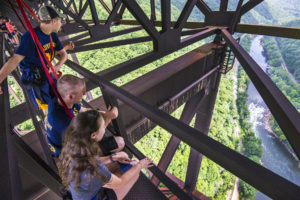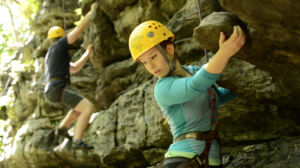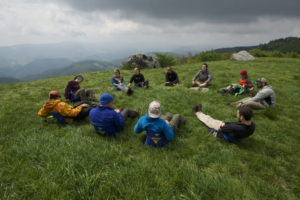By Marion Holmes
Every fall students across the country pack up their belonging and head to colleges and universities to start their first year as college students. These students are met with a host of obstacles as they transition into college, including challenges relating to academics, time management, course and major selection, being away from home and finding a place socially at their new institution.

At larger institutions such as West Virginia University (WVU), the challenges can be intimidating. Students are faced with seemingly limitless options for paths of study and ways to be involved on campus. Students can struggle to find connections and a sense of belonging on campus, which can lead to challenges and setbacks in their academic progression. Many incoming WVU students address these challenges prior to stepping foot on campus for their first classes by choosing to participate in the Adventure West Virginia First Year Trips Program (AWVFYT), formerly known as orientation trips.
The First Year Trips program is one of nearly 200 outdoor orientation programs at colleges and universities nationwide that assist students’ transition into college. According to a census completed by University of New Hampshire (UNH) professor and outdoor orientation expert Dr. Brent Bell, these outdoor orientation programs are defined as small group experiences, usually including between eight and 22 incoming students, and typically have an off-campus and/or adventure component led by highly trained peer leaders. Programs are usually coordinated by a professional director and often involve activities such as hiking, camping, backpacking, rock climbing, paddling and service.

According to research pioneered in the 1980s by UNH’s Dr. Michael Gass and continued recently by Bell, these programs are effective at increasing students’ connections to each other, upperclassmen and the institution and generally support a student’s sense of belonging. Furthermore, because of these outcomes, programs have been shown to increase important student metrics such as GPA and retention. The AWVFYT program is no exception. Working with the WVU Institutional Research team, the program has demonstrated notable gains in GPA and retention among participants when compared to nonparticipants, even when controlling for potentially confounding variables. Beyond the research, the program has a robust history and a welcome reception on the WVU campus.
“It made sense to me to use our state’s tremendous outdoor recreation resources as a vehicle to help students build meaningful relationships, connect with WVU and fall in love with West Virginia,” says Greg Corio, WVU’s executive director of student recreation and outdoor education and founder of Adventure West Virginia. “After seeing the impact the first trips had on our students, I knew we were onto something special. I especially appreciate how the program fosters a love for the state among our out-of-state students and how our in-state students come away from their trip with more West Virginia pride.”
Student participants offer the program high praise. “The trip was potentially one of the greatest weeks of my life,” says past participant Cassidy Brown. “Making connections with other students, learning about the university and growing my passion for West Virginia, all while enjoying the great outdoors—I couldn’t have asked for a better week.”

Hayley Harman is a former AWVFYT participant who became a trip leader. “It was an amazing way to meet 20 people who shared my anxieties about entering college,” she says. “On move-in day, we were all wearing our shirts and were already friends. We already had a community formed and were ready to support one another on the first day. I would definitely do it again, and I would absolutely recommend it to a friend.”
The AWVFYT program stands in the vanguard of outdoor orientation programs. Its scale, scope and support are largely unprecedented, and the program serves as a model for other programs nationwide. Enrollment in the 2017 season was more than 1,000 students, and a range of activities and accommodations were offered. Student participants could choose to have a full backpacking experience carrying all the supplies, clothing and food they would need for five days on their back and pitching camp every night or accommodations in cabins and food served in a dining hall. First year trips are directed by professional staff but led fully by peer leaders who go through a selective application process and rigorous six-month training period. The program runs multiple trips per week, starting in early June and ending in mid-August, and partners with many departments and colleges throughout WVU to offer department-specific programming. The First Year Trips program is heavily subsidized by the WVU Office of the Provost—students pay $95 or less for the six-day, all-inclusive experience. This investment yields rewards for WVU, too. For every $1 invested, the program returns $10.60 in tuition and fees.
Adventure West Virginia is already in the planning stages for its 2018 First Year Trips summer. Every year, the program gathers feedback from various stakeholders, including participants, staff, family members and institutional partners and uses this feedback to improve program quality and meet the needs of students and the greater WVU community. The 2018 summer is already shaping up to be the biggest yet, and the staff is excited to provide meaningful and impactful experiences for next year’s incoming class.
 About the Author
About the Author
Marion Holmes has run the AWVFYT program at WVU since 2013. Prior to her work at WVU, Holmes coordinated the outdoor orientation program at the University of North Carolina at Charlotte. She completed a master’s degree in outdoor education at the University of New Hampshire and holds a bachelor’s degree from Harvard University. In her free time, she travels with her daughter, drinks coffee and runs marathons.








